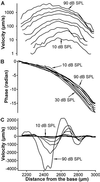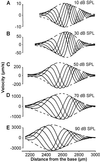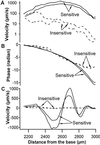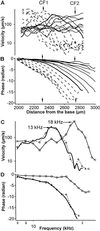Longitudinal pattern of basilar membrane vibration in the sensitive cochlea
- PMID: 12461165
- PMCID: PMC139276
- DOI: 10.1073/pnas.262663699
Longitudinal pattern of basilar membrane vibration in the sensitive cochlea
Abstract
In the normal mammalian ear, sound vibrates the eardrum, causing the tiny bones of the middle ear to vibrate, transferring the vibration to the inner ear fluids. The vibration propagates from the base of the cochlea to its apex along the cochlear partition. As essential as this concept is to the theory of hearing, the waveform of cochlear partition vibration has yet to be measured in vivo. Here I report a "snapshot" (the instantaneous waveform of cochlear partition vibration) measured in the basal turn of the sensitive gerbil cochlea using a scanning laser interferometer. For 16-kHz tones, the phase delay is up to 6pi radians over the observed cochlear length (<1,000 microm), and instantaneous waveforms show sound propagation along the cochlear partition, supporting the existence of the cochlear traveling wave. The detectable basilar membrane response to a low-level 16-kHz tone occurs over a very restricted ( approximately equal 600 microm) range. The observed vibration shows compressive nonlinear growth, a shorter wavelength, and a slower propagation velocity along the cochlear length than previously reported. Data obtained at different frequencies show the relationship between the longitudinal pattern and frequency tuning, demonstrating that the observed localized traveling wave in this study is indeed the spatial representation of the sharp tuning observed in the frequency domain.
Figures




References
-
- Zwislocki J. J., (2002) Auditory Sound Transmission: An Autobiographical Perspective (Lawrence Erlbaum, Mahwah, NJ).
-
- von Békésy G., (1960) Experiments in Hearing (McGraw–Hill, New York).
-
- Khanna S. M. & Leonard, D. G. (1982) Science 215, 305-306. - PubMed
-
- Rhode W. S. (1971) J. Acoust. Soc. Am. 49, 1218-1231. - PubMed
-
- Sellick P. M., Patuzzi, R. & Johnstone, B. M. (1982) J. Acoust. Soc. Am. 72, 131-141. - PubMed
Publication types
MeSH terms
Grants and funding
LinkOut - more resources
Full Text Sources
Other Literature Sources
Research Materials
Miscellaneous

